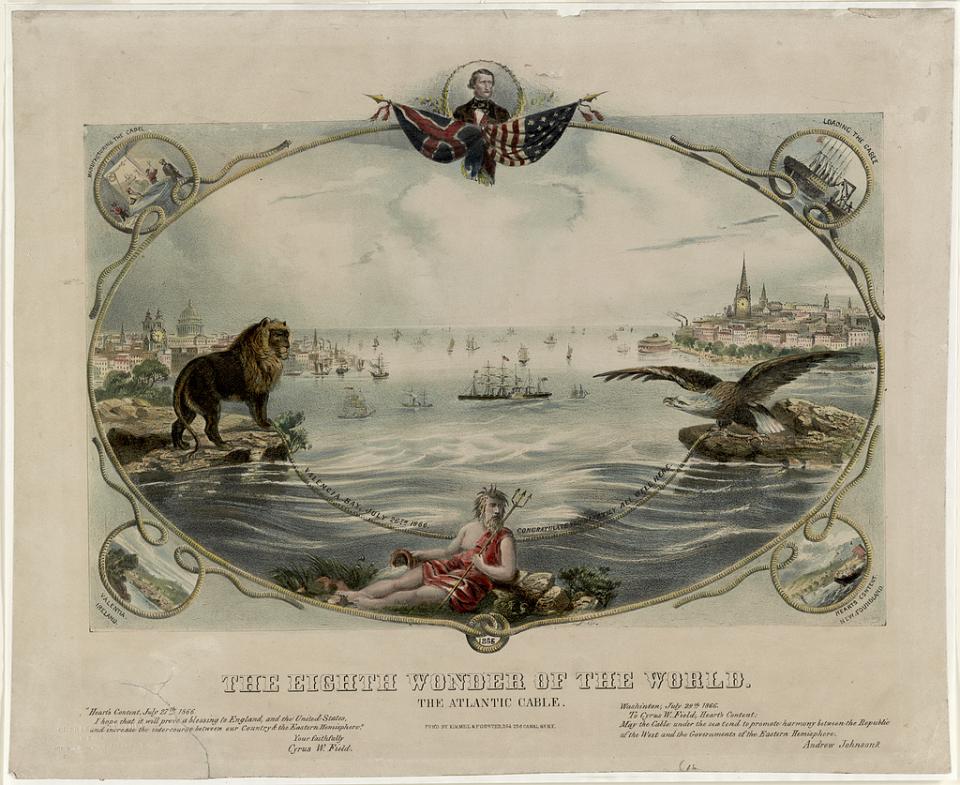Copyright information
This exhibition was created by Helen M. Rozwadowski in 2020 under a CC BY 4.0 International license. This refers only to the text and does not include image rights.
Images used in the exhibition carry individual licenses (please click on an image for information). The images below are featured on the exhibition landing page.

This strikingly unusual example of the Hudson River style of American landscape art, Edward Moran’s Valley in the Sea (1862), depicts an imagined panoramic view of the Atlantic seafloor. Probably commissioned in honor of the first successful transatlantic cable laying of 1858, this painting reflects the mid-century cultural discovery of the deep ocean that was also manifested by the popularity of marine natural history, beach holidays, yachting, maritime novels, and other ways that ordinary people engaged experientially and imaginatively with the sea.
This strikingly unusual example of the Hudson River style of American landscape art, Edward Moran’s Valley in the Sea (1862), depicts an imagined panoramic view of the Atlantic seafloor. Probably commissioned in honor of the first successful transatlantic cable laying of 1858, this painting reflects the mid-century cultural discovery of the deep ocean that was also manifested by the popularity of marine natural history, beach holidays, yachting, maritime novels, and other ways that ordinary people engaged experientially and imaginatively with the sea.
Edward Moran, The Valley in the Sea, 1862. Oil on canvas.
Courtesy of the Indianapolis Museum of Art. Click here to view source.
 This work is licensed under a Creative Commons Public Domain Mark 1.0 License.
This work is licensed under a Creative Commons Public Domain Mark 1.0 License.

Allegorical scene celebrating the successful 1866 laying of the transatlantic telegraph cable, bridging Britain, represented by the lion, and the United States, represented by the eagle. King Neptune rests on the ocean floor as if welcoming and protecting the wires and the instantaneous communication between continents they enabled. Submarine telegraphy represents a rare instance when the ocean acting as bridge (or moat, in the years in which efforts to lay the cable were unsuccessful) involved the seafloor rather than its surface. Illustration by Kimmel & Forster, 1866.
Allegorical scene celebrating the successful 1866 laying of the transatlantic telegraph cable, bridging Britain, represented by the lion, and the United States, represented by the eagle. King Neptune rests on the ocean floor as if welcoming and protecting the wires and the instantaneous communication between continents they enabled. Submarine telegraphy represents a rare instance when the ocean acting as bridge (or moat, in the years in which efforts to lay the cable were unsuccessful) involved the seafloor rather than its surface. Illustration by Kimmel & Forster, 1866.
Courtesy of the Library of Congress. Click here to view source.
 This work is licensed under a Creative Commons Public Domain Mark 1.0 License.
This work is licensed under a Creative Commons Public Domain Mark 1.0 License.

Photograph by John Williamson, n.d.
Photograph by John Williamson, n.d.
Originally published in J. E. Williamson, Twenty Years Under the Sea (Boston and New York: Halse, Cushman & Flint, 1936).
 This work is licensed under a Creative Commons Public Domain Mark 1.0 License.
This work is licensed under a Creative Commons Public Domain Mark 1.0 License.

On the right is a healthy reef in American Samoa in December of 2014. In February 2015, during a bleaching event, the same reef is shown on the photograph on the left. Warmer than usual water temperatures can cause bleaching; the white color results from the coral expelling its symbiotic algae in response to the temperature shift, leaving the coral stressed and the reef covered with slime. This image comes from the Coral Reef Image Bank, a resource created in recognition of the importance of visual imagery in inspiring conservation and climate action. Scientists predict that if humans disappeared from Earth, reefs and most marine species would recover, reminding us that we need the ocean more than it needs us. Photograph by the Ocean Agency, n.d.
On the right is a healthy reef in American Samoa in December of 2014. In February 2015, during a bleaching event, the same reef is shown on the photograph on the left. Warmer than usual water temperatures can cause bleaching; the white color results from the coral expelling its symbiotic algae in response to the temperature shift, leaving the coral stressed and the reef covered with slime. This image comes from the Coral Reef Image Bank, a resource created in recognition of the importance of visual imagery in inspiring conservation and climate action. Scientists predict that if humans disappeared from Earth, reefs and most marine species would recover, reminding us that we need the ocean more than it needs us. Photograph by the Ocean Agency, n.d.
© Ocean Agency.
Click here to view source.
Free to use.
The copyright holder reserves, or holds for their own use, all the rights provided by copyright law, such as distribution, performance, and creation of derivative works.

Photograph by Aaron Burden.
Photograph by Aaron Burden.
Photo by Aaron Burden on Unsplash
The copyright holder reserves, or holds for their own use, all the rights provided by copyright law, such as distribution, performance, and creation of derivative works.









